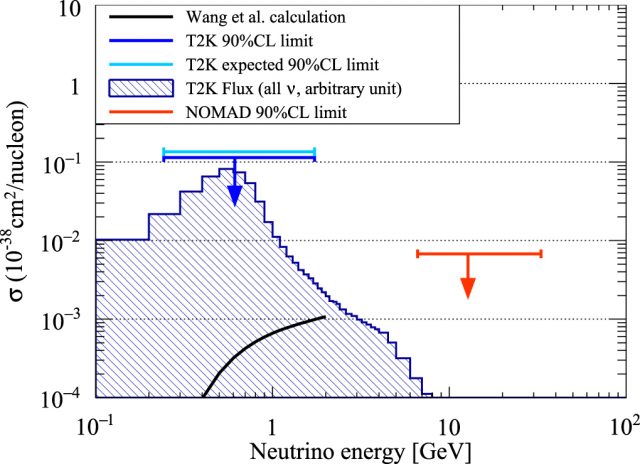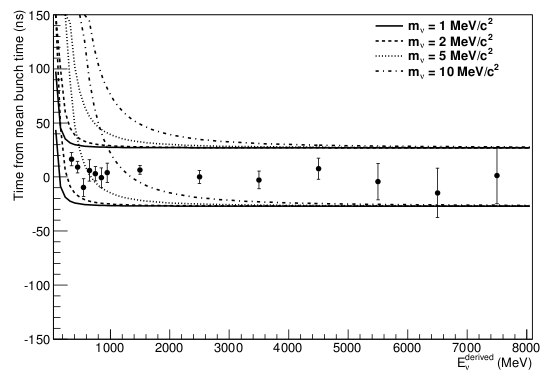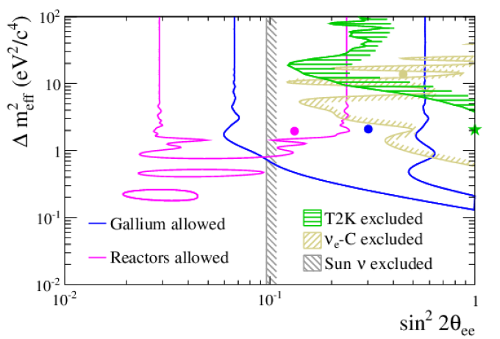Search for neutral-current induced single photon production at the ND280 near detector in T2K
DOI: https://dx.doi.org/10.1088/1361-6471/ab227d
ArXiv: https://arxiv.org/abs/1902.03848
Physics World: https://physicsworld.com/a/t2k-searches-for-single-gamma-rays-from-neutrino-interactions

Search for light sterile neutrinos with the T2K far detector Super-Kamiokande at a baseline of 295 km
link to publication : https://journals.aps.org/prd/abstract/10.1103/PhysRevD.99.071103
There is a data release for this paper here

Search for heavy neutrinos with ND280
This paper (Phys. Rev. D 100, 052006 (2019)) reports on the search for heavy neutrinos with masses in the range 140 < MN <493 MeV/c2 using the off-axis near detector ND280 of the T2K experiment. These particles can be produced from kaon decays in the standard neutrino beam and then subsequently decay in ND280. The decay modes under consideration are N→l_α π and N→l_α l_β ν (α,β=e,μ). A search for such events has been made using the Time Projection Chambers of ND280, where the background has been reduced to less that 2 events in the current dataset in all channels. No excess has been observed in the signal region. A combined Bayesian statistical approach has been applied to extract upper limits on the mixing elements of heavy neutrinos to electron-, muon- and tau- flavoured currents (Ue2, Uμ2, Uτ2) as a function of the heavy neutrino mass, e.g. Ue2 < 10^(−9) at 90% C.L. for a mass of 390MeV/c2. These constraints are competitive with previous experiments.
There is a data release for this paper here.
Search for Lorentz and CPT violation using sidereal time dependence of neutrino flavor transitions over a short baseline
A class of extensions of the Standard Model allows Lorentz and CPT violations, which can be identified by the observation of sidereal modulations in the neutrino interaction rate. A search for such modulations was performed using the T2K on-axis near detector. Two complementary methods were used in this study, both of which resulted in no evidence of a signal. Limits on associated Lorentz and CPT-violating terms from the Standard Model extension have been derived by taking into account their correlations in this model for the first time. These results imply such symmetry violations are suppressed by a factor of more than 1020 at the GeV scale.
Upper bound on neutrino mass based on T2K neutrino timing measurements

The present work utilizes the T2K event timing measurements at the near and far detectors to study neutrino time of flight as a function of derived neutrino energy. Under the assumption of a relativistic relation between energy and time of flight, constraints on the neutrino rest mass can be derived. The sub-GeV neutrino beam in conjunction with timing precision of order tens of ns provide sensitivity to neutrino mass in the few MeV/c2 range. We study the distribution of relative arrival times of muon and electron neutrino candidate events at the T2K far detector as a function of neutrino energy. The 90% C.L. upper limit on the mixture of neutrino mass eigenstates represented in the data sample is found to be mν2<5.6 MeV2/c4.
Search for short baseline νe disappearance with the T2K near detector

The T2K experiment has performed a search for νe disappearance due to sterile neutrinos using 5.9×1020 protons on target for a baseline of 280m in a neutrino beam peaked at about 500MeV. A sample of νe CC interactions in the off-axis near detector has been selected with a purity of 63% and an efficiency of 26%. The p-value for the null hypothesis is 0.085 and the excluded region at 95% CL is approximately sin22θee > 0.3 for Δm2eff > 7eV2/c4.


